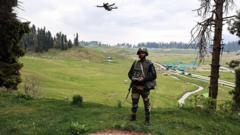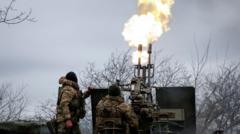As India and Pakistan confront each other in the disputed Kashmir region, the introduction of drones into their military arsenal raises concerns. While unconfirmed claims suggest the use of Turkish and Israeli drones, experts see the situation as an escalation yet to reach nuclear proportions. The rapid growth of drone technology among both nations signifies a new chapter in their long-standing rivalry.
Drones Escalate Tensions in India-Pakistan Conflict

Drones Escalate Tensions in India-Pakistan Conflict
The use of drones by India and Pakistan marks a troubling evolution in their military engagement, with both nations accusing each other of deploying foreign technology.
Tensions between India and Pakistan are escalating as the introduction of drones complicates their military conflict. In recent developments, both nations have reported using foreign-sourced drones, with India claiming that Turkey's unmanned aerial vehicles (UAVs) are being deployed by Pakistan and Pakistan asserting that Israel's drones are being utilized by India. However, independent verification of these claims remains elusive.
The ongoing conflict, particularly in the disputed Kashmir region, has evolved with the proliferation of drone technology, which has become increasingly commonplace in modern warfare. Both countries have been developing their respective drone industries while also relying on imports from allied nations. The current usage is primarily focused on one-way kamikaze drones, a tactical choice observed in various global conflicts, including the recent war in Ukraine.
James Patton Rogers, an expert on drone warfare at Cornell University, pointed out that neither side is deploying drones capable of carrying nuclear payloads, offering a glimmer of cautious optimism despite the alarming nature of the conflict. He suggested that the initial deployment of drones represents a low-level escalation, often employed to gauge an adversary's defenses and tactics.
Contrasting the capabilities of both nations, Rogers noted that India possesses a more advanced drone industry, encompassing a broader range of technologies from ground to naval drones, while Pakistan's capabilities, though growing, remain relatively limited. The recent training of drone operators and ongoing development indicates a shift in operational strategy, as both nations share a confirmed arsenal of more than 100 drones combined.
Experts warn that both nations are likely to continue utilizing drones for intelligence gathering on each other’s military positions, potentially leading to an escalation if traditional air and missile strikes come into play. Shuja Nawaz, a former director at The Atlantic Council’s South Asia Center, expressed concern that persistent frustrations over the effectiveness of drone strikes could lead to an increased reliance on more aggressive military tactics.
As the landscape of warfare continues to evolve, the implications of drone usage in the region indicate a complex and dangerous future for the relationship between these two nuclear-armed neighbors.


















